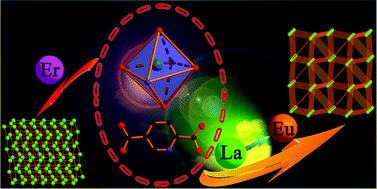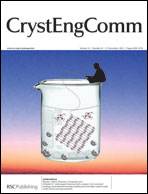Seven organic–inorganic hybrid lanthanide dimolybdates [Ln(H2O)6Mo2O6(Hpydc)(pydc)]·nH2O (n = 0: Ln = LaIII (1), CeIII (2), PrIII (3), NdIII (4), SmIII (5); n = 0.5: Ln = EuIII (6)), and Na0.5H0.5[Er(H2O)5Mo2O6(pydc)2]·3H2O (7) (H2pydc = pyridine-2,5-dicarboxylic acid) have been hydrothermally prepared and further characterized by elemental analyses, X-ray powder diffraction (XRPD), IR spectra, thermogravimetric (TG) analyses, and single-crystal X-ray diffraction. The common feature of 1–7 is that they all consist of LnIII cations and MoIV centers connected by oxygen atoms and H2pydc ligands. 1–6 show unprecedented 3D 8-connected networks with the Schläfli symbol of (34·417·54·63), while 7 exhibits the 2D 4-connected (45·6) structure. Furthermore, the luminescence properties of 5 and 6 are derived from the combination of Ln cations and H2pydc ligands, whereas 1–4 and 7 are attributable to H2pydc ligands.
You have access to this article
 Please wait while we load your content...
Something went wrong. Try again?
Please wait while we load your content...
Something went wrong. Try again?


 Please wait while we load your content...
Please wait while we load your content...